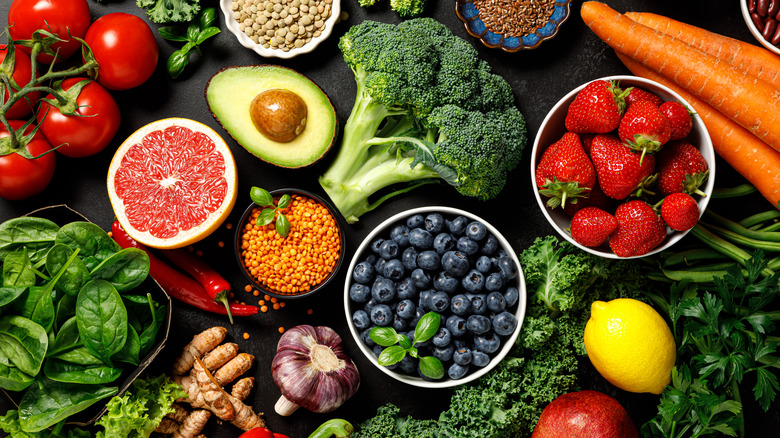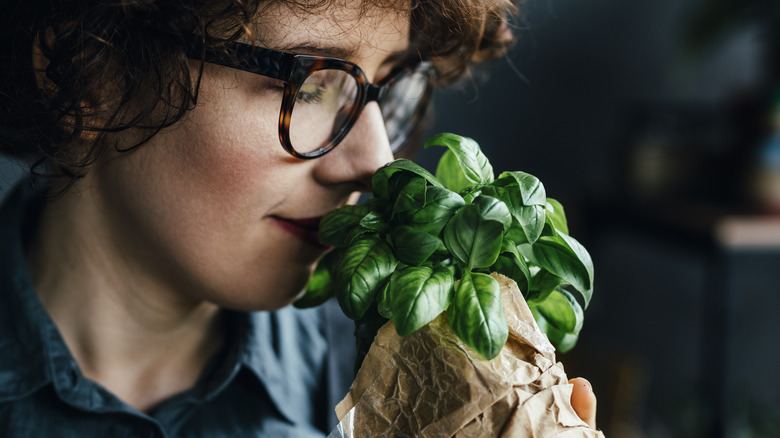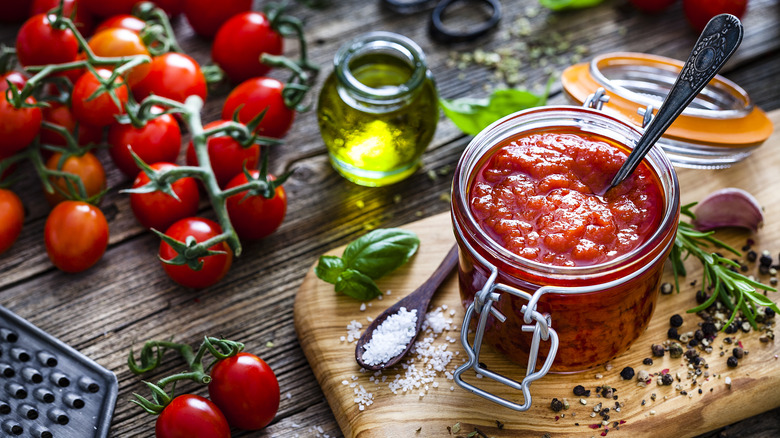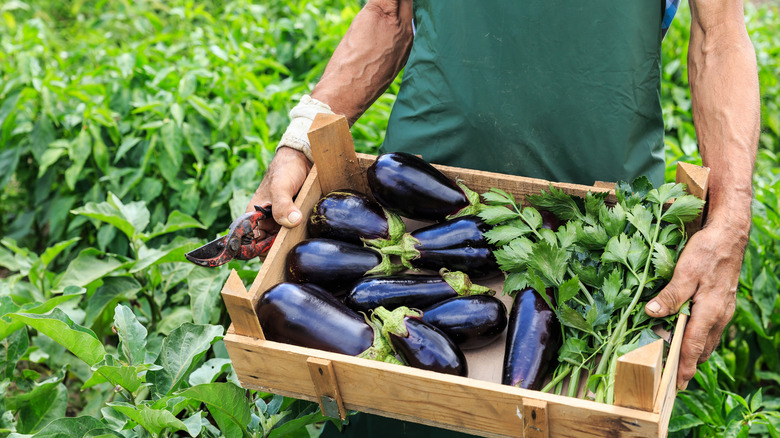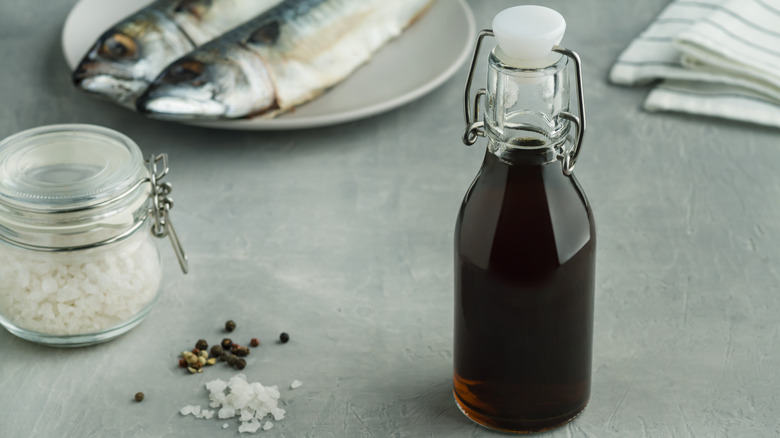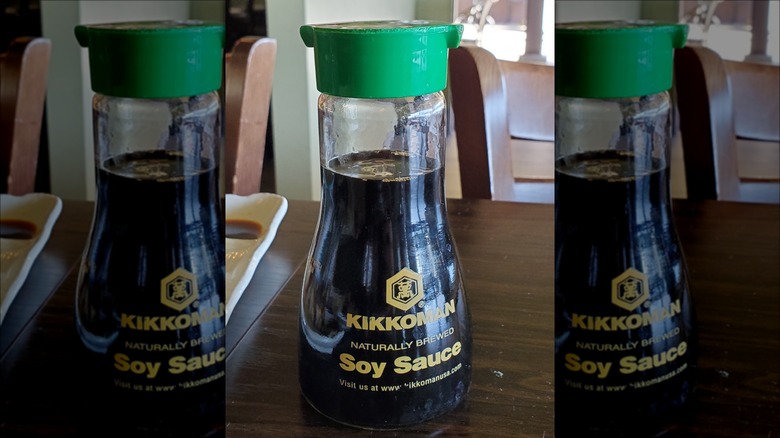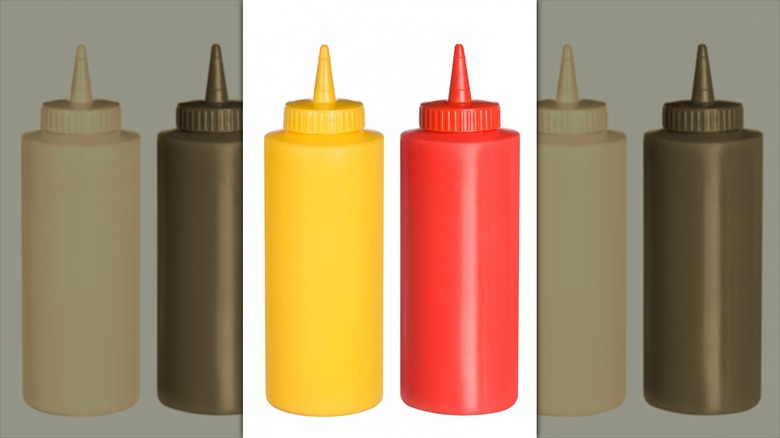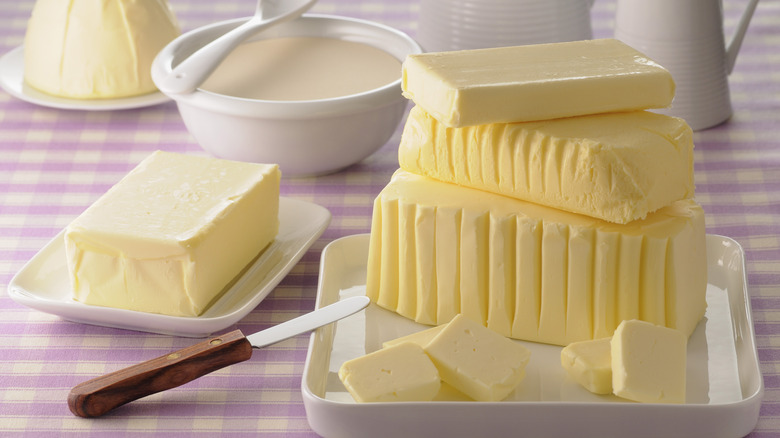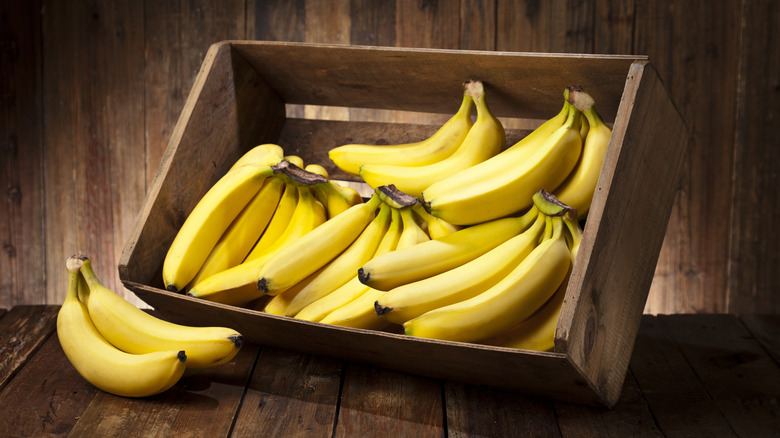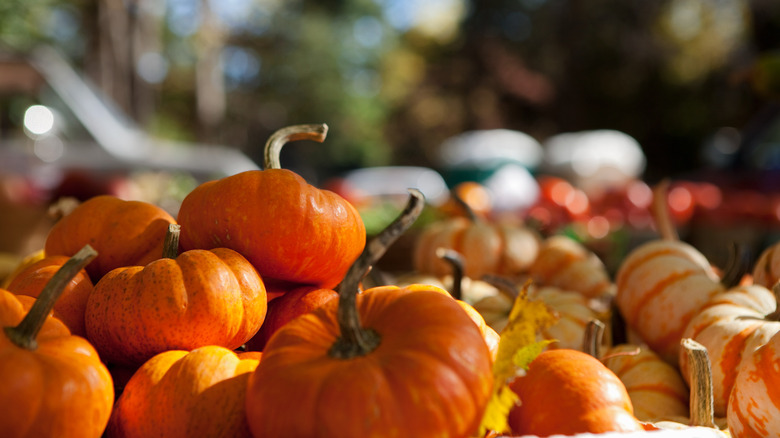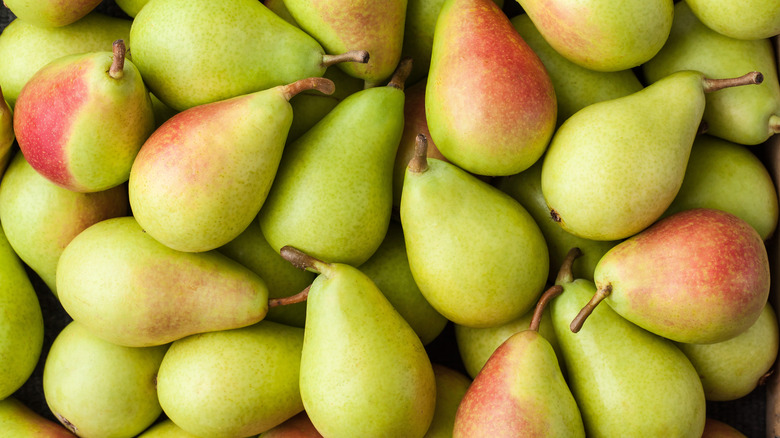11 Unexpected Foods You Actually Don't Have To Refrigerate
When you take a stroll around the produce aisle, you notice a few things. Aside from fruits and vegetables being grouped by color, usually, there are also fruits and vegetables, like apples and tomatoes, that you'll only see out in the open bins, sitting at room temperature, and other produce, like mushrooms and lettuce, that you'll only see in the refrigerator section.
Still, despite this, some question remains about which items belong in the fridge and which can hang out in their own bins. Some of this confusion comes from how we did things growing up. If your mom kept everything but the kitchen sink in the fridge, you probably do, too. You may also be confused about which foods get to chill in the fridge and which get to chill out in the open, so to speak, partly because misinformation abounds on the Internet. A lot of the information is conflicting.
It's also worth noting that just because you can leave something out of the refrigerator doesn't mean it can be left out indefinitely. Eventually, all food will start to break down, whether it's refrigerated or not. To help you, our favorite foodies, clear up any confusion about this, we've compiled a list of foods that are just as comfortable hanging out on your kitchen counter as they are in the open produce bins at the store, as well as talk about how long the food in question can stay on the counter until you need to eat it.
1. Coffee
It turns out that your morning bean jolt comes with some pretty magical qualities, including being a deodorizer. When your apartment smells bad, a few bowls filled with coffee, strategically placed all around your abode, soak up the sullied scents. Unfortunately, the same is also true of coffee placed in your refrigerator or freezer. That is to say, your bag of beans will pull any offending odors out of your refrigerator. While this may make your fridge smell better, it makes your coffee taste worse because it now contains not only the flavor of coffee but the flavor of everything else in the fridge.
Fortunately, it's also not necessary to store your coffee in the fridge to keep it fresh. Finding a cool, but not cold, dry place that's out of the way of direct light works just fine. A container that you can't see through does the trick. Basically, instead of giving it a place of honor in your fridge, you want to give it a place of honor in your pantry. It's also worth noting that, unless you live with a small army, it's best not to buy too much coffee all at once. Roasting, the process that makes our coffee taste so grand, also contributes to its loss of freshness over time. Buy enough coffee to keep for a week or two and no more.
2. Basil
The scent of basil wafting through the air when your porch box garden begins to bloom is a wonder to behold. The lush green leaves and sweetly seasoned scent make resistance pretty much futile. If you think like most people, you want to preserve this deliciousness for as long as possible. So, after you've plucked the basil leaves from their stems, you may put them in the fridge to keep them fresh until you can toss them into your homemade spaghetti sauce. Imagine your horror when, upon examination, you discover that your once-plump green basil leaves now have taken on a decidedly black hue. You've just learned the hard way that fresh basil requires no refrigeration.
Instead of refrigeration, you should treat your basil as if it were a cut flower. That is, it's best to cut the stems a bit, then immerse your bunch of basil in a pitcher of water. Create a cover for the basil out of plastic and place the cover over the basil like a tent. Once you do this, you can leave it to fragrance up your counter for up to a week. Just be sure to switch out the old water every couple of days to keep it from looking cloudy. Once it comes time to cook with your basil, you'll just grab a few leaves from your bouquet and toss them into the spaghetti sauce pot, along with your other seasonings.
3. Tomatoes
Unless room temperature in your home is 110 degrees Fahrenheit all day, every day, your best bet for keeping your tomatoes perky is to keep them out of the fridge. Like all fresh fruits and vegetables, tomatoes contain myriad enzymes. For the purposes of the conversation we're having here, you should know that tomatoes contain enzymes, which may be difficult to pronounce but that have very easy-to-see effects on the tomatoes. In other words, in the right conditions, those enzymes encourage tomatoes to go all mushy and mealy on you if the tomatoes are kept in the refrigerator.
But there is more at stake than just the red one's texture. Chilling in the fridge robs the tomato of its flavor over time. First off, tomatoes are a scent magnet, meaning if you need to clear your fridge of the smell of yesterday's science experiment, your tomatoes will happily suck in those scents for you. Aside from that, cold kills the taste of your tomato.
In light of all of this, your best bet is to protect your tomatoes from direct sunlight. If you do, you should be able to keep them out on the counter for a week or so. After that, you should eat them. One final common sense note: Once you cut into a tomato, you can store the remainder of it in the fridge until you're ready to finish it, but don't leave it there for more than a couple of days.
4. Eggplant
Your eggplant will keep for around four days at room temperature if you stash it in a bowl with vents. If you have no such thing, pull out the paper bag that you got from your last trip to the neighborhood co-op and put the eggplant in there. Once stashed or bagged, you should eat the eggplant within the four-day window.
Cool and dry is the key here. Eggplants respond best when you can store them at temperatures between 50 degrees and 54 degrees Fahrenheit. Your fridge runs cooler than that. If your kitchen cupboards stay reasonably cool and are devoid of moisture, your eggplant can live comfortably in there until you're ready to make your next eggplant Parmesan. If not, then you may need to carve out some space for your eggplants in the basement or your garage, provided that the latter doesn't get too hot. If you have a spot where you stash other fruits and vegetables, be mindful of the fact that fruits like apples and bananas give off ethylene gas. Eggplants stored next to them ripen faster due to exposure to this gas.
If you feel like you have to put your eggplant in the fridge, beware. You'll find soft spots and brassy-looking streaks spring up all over it. The fruit and seeds may also take on brownish spots. These are the negative effects that cold temperatures have on eggplants, which is why they're better on the counter.
5. Fish sauce
Fish sauce, that pungent ingredient that makes recipes like pad thai taste so good, arises from plopping a great deal of fish, usually anchovies, into buckets of salt and letting them soak up the salt for many moons. The process eventually ferments the fish, leaving behind the umami-flavored oil that packs such a punch in so many recipes, Asian and non-Asian alike. Basically, any dish that calls for salt could use a bit of fish sauce as a substitute if you feel so inclined. In light of that, it's a pretty handy condiment to keep in your cupboard.
If that's a head-scratcher for you, we get it. How could fish anything be happy in a cupboard instead of the fridge? It comes down to the fermenting process, a preservation process that's been around since time immemorial. Unopened fish sauce lasts in your cupboard for a couple of years, while opened fish sauce will be good for about six months. That said, you may prefer to put fish sauce in the fridge after opening because the unsealed bottle will allow the fishy odor to permeate your cupboards. Eventually, everything in the cupboard could have that pungent fishy scent, including your muffin and cake mixes.
6. Soy sauce
Soy sauce. If you've ever been to an Asian restaurant, and we assume you have been, then you know that soy sauce is ubiquitous. It sits on every table, right next to the salt and pepper, and if the salt and pepper are conspicuously absent, you will probably still find a bottle of soy sauce on each table. This dark brown liquid comes from soybeans, which have undergone a two-step fermentation process. Fermenting takes up to six months, and then, voilà! You have soy sauce. As with pretty much all fermented foods, it's the fermentation process that allows Asian restaurants to leave soy sauce on the tables without worrying about it spoiling.
Not convinced? Even Kikkoman, the soy sauce manufacturer, says that it's okay to leave soy sauce out on the counter after you've opened it. However, as with many condiments, refrigeration post-opening can preserve the fresh flavor for longer. If you opt to leave it out on your counter or in your cupboard, do note that it still does have a shelf life, like every other food. It'll be good for around six months before it starts to go south.
7. Ketchup and mustard
No diner cheeseburger experience would be the same without the bottles of ketchup and mustard on the counter. Just knowing that you can squeeze a ginormous amount of your favorite condiment on your burger makes you want to do it all the more (and if you're still a kid at heart, you'll likely draw a smiley face on your burger with said condiments). That restaurants keep both ketchup and mustard on the counter or on the tables points toward these condiments' longevity outside of captivity. That is, it's a testament to whether or not they'll stay good enough to eat once opened.
The short answer is they do, indeed, stay good enough to eat when kept at room temperature, though an opened mustard jar has more of a shelf life than an opened ketchup bottle. Both ketchup and mustard contain ingredients that act as preservatives because the ingredients are acidic. If, like restaurants, you go through a lot of ketchup and mustard, it's okay to leave both out. It's also fair to say that even though you don't have to refrigerate them, they'll taste better if you do.
Still, we understand that hard-core food lovers might want a bottom-line number for each condiment. Just how long can you keep each out? Mustard doesn't go bad because it's filled with ingredients that inherently preserve it, like vinegar, salt, and mustard seeds. Opened ketchup can stay out for about a month before it leaves something to be desired.
8. Butter
Here's a morning annoyance that most have experienced. We slide some hot pancakes onto our plates and start doctoring them up, a routine that usually includes copious amounts of butter, lots of syrup, and maybe some fruit. However, if the butter comes straight from the fridge and hasn't had time to reach room temperature, the doctoring phase does little more than tear up the pancake or the toast or whatever we're trying to butter. It's too cold to spread out.
As it turns out, this dilemma has a pretty easy solution. Just leave the butter out on the counter. It's one of those foods that doesn't need to be stuck in the fridge once it's opened, with some conditions, of course. If your butter of choice contains salt, you can leave the butter out, particularly if the salt content runs on the high side. As for unsalted butter, you should create a hangout spot for it in the fridge.
As it goes with these things, there is a gray area. The U.S. Department of Agriculture (USDA) says that butter can be left out but should be put back into the fridge after a couple of days. However, other food experts say that due to butter's high fat and salt content, it's okay to leave it out for up to 30 days, per Today. Most experts agree that the put-it-away versus leave-it-out argument comes down to taste. Butter left in the fridge tastes better longer.
9. Bananas
Like avocados, bananas don't have a very long shelf life, so it isn't any wonder that you might feel tempted to toss them in the fridge to let them keep for a bit longer. While this move does delay the ripening process, it comes with a big price: chilling injuries. Bananas stored below 55.4 degrees Fahrenheit turn brown. On your countertop, right at room temperature, is where bananas bask best.
It's natural, given the short lifespan of bananas, that you'd want to do something to keep them fresh for longer. More specifically, you're probably hoping not to have to buy them so often. If that's the case, you do have options. When you shop for bananas, buy them in two or three separate bunches in various stages of ripeness if you can. That is, buy a few green bananas, a few slightly green bananas, and a few yellow ones. By the time you're done eating the yellow ones, the slightly green ones should be ripe, provided that you've kept them on the counter. Once those are gone, the last of the batch should be ready to eat. Going this route prevents you from wasting bananas because they've ripened before you could eat them. It also helps you to avoid chilling injuries because you won't be tempted to put them in the fridge to keep them longer.
10. Pumpkins
Pumpkins are a fruit that has a long shelf life, relatively speaking, if you treat them well. They will keep for two or three months at room temperature if you cure them. Curing is a process where you place a pumpkin, with stem on, in the sun for 10 days. Curing is an important part of the process because it makes the fruit's skin more impenetrable to the creepy crawlies that might like to nosh on it. The process also heals up any wounds on the pumpkins' skin, like scratches and cuts. Cured pumpkins don't require refrigeration, though they do require a cool, dry spot to land for the 60 to 90 days they'll be hanging out (or however long it takes you to eat them up).
Once you finish curing them, find a cool, dry spot to spread the pumpkins out. Place a tarp on the ground and then put them on the ground in a single layer. No stacking for efficiency here. Putting them in a single layer on the ground allows them to breathe and stops unwanted heat from working its way through the stack, which breaks down the pumpkins.
Once they're in place in your garage or barn, occasionally check your pumpkins on the bottom to ensure that they're not leaking. When this happens, they'll look right as rain on top but drizzle liquid on the bottom. The tarp will act as a shield for the floor if your pumpkins do start to leak.
11. Pears
Here's a pop quiz for you. Name a fruit that doesn't ripen on the tree. If you blurted out pear, you'd be right. Granted, the quiz wasn't very difficult given that you're currently reading a caption under a photo of pears, but still, it's a good way to start this fridge versus no-fridge debate. In short, pears are a food you'll want to leave on the counter. They'll ripen there.
If you're not sure if the pears are ripe or not after sitting on the counter for a couple of days, you can look for a couple of things. Some pears make it easy for you. They, like your beloved bananas, will change color once they've ripened. Others don't leave such colorful clues. For those, a quick but gentle squeeze of the neck tells you if the pear has ripened. If it has — you'll know because your squeeze meets with softened fruit – you can go ahead and eat it then. The sugars have developed, making the pear sweet and juicy.
After their week spent on the counter ripening, your pears will keep on the counter at room temperature for about an additional four days, give or take a day. If you really can't eat them within that window, you can find a spot for them in the fridge to keep them a tiny bit longer, but keep in mind even refrigerated pears will eventually go bad after a week in the fridge. Nothing lasts indefinitely, particularly fresh fruit.
